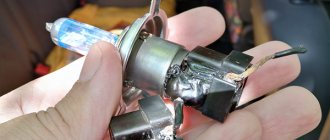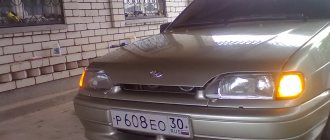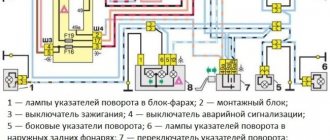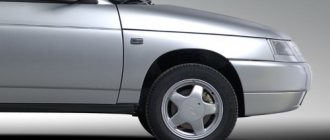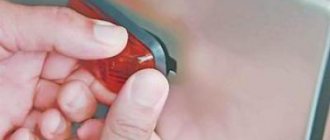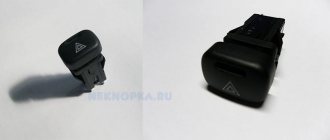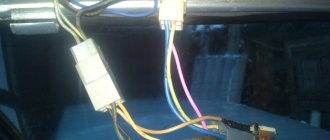If a breakdown of the hazard warning button is discovered on the road, and the hazard warning light itself is urgently needed, then you can make do with “improvised means”. To do this, you need to dismantle the button, disconnect it from the block and connect the two sockets in the block using any metal wire, thereby closing the alarm circuit.
Another cause of failure may be the failure of relay K2. You can find out about this by indirect signs - if the relay is faulty, both the emergency lights and the turn signals will not work. In this case, the relay should be replaced with a new, similar one.
Turn signals don't turn on
Sometimes it happens that the turn signals of the VAZ 2114 do not work.
This may be expressed by the following signs:
- The turn signals do not turn on.
- The turn signals do not turn off.
- The turn signals don't blink.
- The turn signals light up with minimal brightness.
Turn signal relay diagram
In the first case, there may be several reasons (they are almost the same as in the case of problems with emergency lights):
- fuse is blown;
- power buttons are broken;
- contacts have oxidized;
- there was a break in the wiring;
- the relay has failed;
- light bulbs burned out.
Checking the electrical system of turn signals in these situations, as well as eliminating detected problems, should be carried out in the same way as repairing emergency lights (how exactly is described above).
If the turn signals, on the contrary, do not turn off, then there can only be one reason - burnt out switches. They should be replaced with new ones of a similar model.
Sometimes the turn signals may turn on, but remain solid instead of blinking. The reason for this is the incorrect operation of the relay (sometimes this also happens when a device intended for other cars is installed instead of the original relay). To eliminate the cause, it is enough to replace the relay with a new one.
If the turn signals are on but not blinking, you can try gently knocking on the relay body - sometimes this can help, but the effect is usually short-lived.
Turn signal bulbs
In a situation where the turn signals are very dim, you should check the power of the lamps installed in them. If the lamps are suitable, then you need to clean the ground contact connected to the turn signals. This can be done with fine sandpaper or kerosene.
All the light bulbs burned out at once
This is due to a short circuit in the wiring. This is the worst option. The problem may be wandering, the so-called sore. This may cause the ECU to break down or the vehicle to catch fire. All wiring needs to be checked.
Emergency stop and turn signals are one of the most important signaling and lighting devices in a car. They are necessary for safe movement on the road and coordination of motorists with each other. If it happens that the turn signals and emergency lights of the VAZ 2114 do not work, then you cannot continue driving the car (until the breakdown is fixed).
Below we will analyze the main reasons for the malfunction of the light alarm in a car, and also tell you how to eliminate them.
Fuse
To understand why the emergency lights on the VAZ 2114 do not work, the first thing you need to do is check the fuse responsible for it. It is installed in the mounting block under the hood of the car on the left side. This fusible element is designated F2 . To speed up the search, you can use the electrical diagram number fourteen, where its exact location is drawn.
A burnt out or broken part can sometimes be identified visually by the presence of plaque or damaged elements. You can also check the serviceability of the fuse using a multimeter. There are two diagnostic methods.
For the first method, the measuring device must be switched to voltmeter mode and the car's alarm system must be turned on. By connecting the probes of the device to the outputs on the fuse element, determine the presence of voltage on them. If one of them does not have it, the part needs to be replaced. It is inexpensive and can be changed literally with one movement of the hand. You can even make a replacement on the go. Especially if there is an auto parts store nearby.
You can also diagnose the element with this device in ohmmeter mode. To do this, you need to remove it from the car and attach the probes to the outputs. If the resistance is zero, the part should be replaced.
Often the fuse turns out to be serviceable, but its contacts are oxidized. This happens due to dampness and time. In this case, you should simply clean them.
It is worth noting that some motorists with such a breakdown begin to check the K2 relay. But there is no need to waste time diagnosing it, since in this case the turn indicators would not light up either.
Tips for motorists
On a VAZ-2114 car, the electrical circuit of the direction indicators includes 6 lamps located in the front, rear and sides of the car, a relay and under the steering switch. The circuit is protected by fuse F2 (10A), located in the mounting block, and it must be taken into account that the wires included in the electrical circuit of the turn signals go through the hazard warning button block.
The most common malfunction is the burnout of one of the turn signal lamps. The warning light on the instrument panel will tell you about this; it will simply stop blinking. When replacing a burnt-out lamp, install a new lamp of exactly the same power, otherwise the indicators will not work normally. Sometimes the turn signal bulbs in the taillights do not light up not because they are burned out, but because there is a lack of contact with the flexible circuit board due to contamination or corrosion.
If the turn signals do not turn on on either side of the car, then first you need to check the fuse. If it is blown, then before installing a new fuse, you need to find the reason for its failure. Most likely, some wire included in the electrical circuit of the turn signals is shorted to ground. This is usually caused by the wires going to the side turn signals.
If the fuse is working, check the turn relay K2. This can be done by installing your relay on a similar car. We turn on the direction indicators and if they work, then your relay is working properly, and if not, it will have to be replaced.
Power button
Sometimes the alarm system stops working due to the failure of its activation button. When removed, sometimes its defects are visually visible. In order for the light fixture to function again, the part will need to be replaced.
If trouble happens on the road, you can temporarily restore the functionality of the emergency lights without having to buy a new button. To do this, you will need to remove it and disconnect it from the block. Using a paper clip or wire, make a jumper that will close the contacts of the block. The part must be positioned so that the cutout on one of the faces is at the bottom. Insert the jumper into the middle socket in the left row of contacts. Secure its second end into the lower socket of the adjacent row. If everything is done correctly, the hazard warning lights and turn signals will work as normal.
Turn signal closes
See the rear headlight unit. The taillight board is the weak point of our cars. Most likely the problem again lies in the oxide of the tracks. As a result of corrosion, different tracks come into contact and short circuit, as a result of which the fuse then blows.
Therefore, in principle, there are two main options for the failure of the hazard warning system, either it does not want to turn on itself, but the direction indicators work, or both of these electrical circuits do not work at the same time. In the first case, you will have to look for a fault in the mounting block and the alarm button, and in the second case you will have to check the functionality of the K2 relay.
The search for an emergency signal malfunction in the mounting block of a VAZ-2115 car begins with checking the 10-amp fuse F2. If it burns out, then you will have to look for the reason for its failure, usually it is a short circuit in the electrical circuit that it protects. There is little point in installing a new fuse without finding the short fuse, since it will also burn out.
It also happens that fuse F2 turns out to be intact. Then, using a test lamp or tester, you need to check whether voltage is supplied to its terminals. If there is no voltage, you will have to check whether voltage is supplied to terminal 3 of block X1 of the mounting block, since it is the positive that is supplied to it from terminal 15 of the ignition switch. If there is voltage at the 3rd terminal, we can conclude that an open circuit is located on the mounting block board from terminal 3 of the X1 block to the fuse terminal F2.
If fuse F2 is intact and there is voltage at its terminals, then remove the alarm button from the front panel, disconnect the block and check the voltage at terminal 2 of this block, naturally with the ignition on. If there is voltage at terminal 2, the culprit for the failure of the alarm will be its power button, which will have to be replaced. And if there is no voltage at terminal 2, then you will need to “ring” the wire running from terminal 2 of the alarm block to terminal 3 of the X4 connector of the mounting block.
If the hazard warning lights and direction indicators do not work, you will have to check relay K2. The easiest way to check would be to install instead of it, exactly the same, but serviceable relay.
Related posts:–>
Diagnostics and repairDecember 14, 2019
Turning lights are an important part of the optical system of any car. They are designed to warn other drivers about a planned maneuver. There are many reasons why turn signals and hazard lights do not work. You can repair them yourself by first identifying the fault.
Dubious savings
After my post about the mysterious current consumer, I suddenly got a subscriber!) Thank you, friend! This post is for you!
Once upon a time there was a man who drove a Korean SUV. Somehow the wires in the fifth door broke, someone repaired them, but my friend drove on, not knowing grief. But again the wires frayed and his fuse blew. One fuse had blown - a new one was installed in its place, and that one had blown. Our hero got tired of this, and he installed a “bug” jumper in place of the fuse. She did not burn out, but honestly passed current through herself to a short circuit. And the wiring with broken insulation began to heat up, and strongly - melting its insulation from the trunk to the mounting block.
As a result: replacement of the wire (disassembly of the interior trim and the fifth door, search and replacement of the burnt-out wire, resoldering of the wires at the bend, assembly. The amount turned out to be quite large. If I had contacted the beetle before installing it, it would have been much cheaper. Moral: be careful with the electrics your car, in case of malfunctions, contact specialists, do not engage in amateur activities such as replacing fuses with fireproof jumpers.
Signs and causes of malfunctioning turn signals and emergency signals
These elements of the lighting system stop working due to:
- Blown fuse box in the passenger compartment. This problem occurs often. If the car is equipped with a relay that regulates the operation of lighting devices, the cause should be looked for in it. Depending on the make of the car, this part may be located at different distances from the fuses. The diagram attached to the instructions helps you find it.
- Short circuits in the on-board network. Because of this, the turn lights do not light up and the hazard warning lights go off instead. The system stops responding to user commands. To detect a breakdown, you will need a multimeter. The driver must understand the electrical circuit.
- Failure of the lighting source. In this case, replace the burnt out light bulb.
- Broken wiring. This is what owners of outdated VAZ car models face. If the wires are laid in places where there are moving parts, the braid will fray over time. The integrity of the electrical circuit section is compromised.
- Failure of the turning light control element or steering column switch. In this case, a thorough diagnosis of the control buttons is required.
The following signs help determine the presence of malfunctions in the optical system of the machine:
- The turn signals are on continuously. The symptom appears when the relay breaks down, in particular its electromagnetic component. It often gets stuck in one position, causing it to be unable to return to its original position.
- The blinking frequency of the turning lights has changed. The source of this malfunction is not only the relay, but also the wrong type of light bulb. When purchasing new lighting products, take into account the value declared by the car manufacturer.
- The optical system is not functioning. Not only the lights do not light up, but also the indicators on the center console. The clicks that occur when the indicators are turned on are not observed. There are many reasons for such malfunctions.
Useful video
You can get additional interesting information from the video below:
It is no secret that the hazard warning and turn signal circuits are interconnected, because the first and second functions are performed by the same headlights. If the turn signals do not work, but the emergency lights do their job, or both signals ignore the driver’s commands, this can lead to an accident on the road.
Main causes of malfunction
What could be causing the problem? There are several reasons:
- The fuse has blown. The problem is considered the most common. If your car has a relay that switches the hazard warning lights and turn signals, then this could be the reason. Please note that the part can be mounted either in the main fuse box or separately from it - it all depends on the car model. To find the device, use the diagram.
- The light bulb has burned out. This is another reason why turn signals and emergency lights do not work.
- Short circuit in the wiring. When a command to turn on is given, the signals may be confused. For example, the driver activates the hazard warning light and the turn lights are activated, or vice versa. If there is a short circuit, the optics may not react at all to the actions of the car owner. To diagnose a breakdown, you need a tester and basic knowledge of the electrical part.
- Damage to the switch under the steering wheel or button. To identify a malfunction, it is necessary to check the functionality of these devices.
- Open circuit. This breakdown is typical for older cars. If the wires are laid in places where there are moving parts, the wiring may become chafed. As a result, the chain breaks.
How to check the operation of lighting devices with your own hands?
If the turn signals or emergency lights do not work, this is not a reason to despair - all diagnostic work can be done with your own hands. First, determine that the light signals really need to be checked. This is done for a number of reasons:
- There are no turn signals, but the lights are on. This problem indicates a failure of the relay, namely its electromagnetic part. As a rule, a malfunction indicates a short circuit of the electromagnet in one of the positions and the impossibility of returning to its original position.
- The turn signals work, but too slowly or in accelerated mode. With such symptoms, the cause of the malfunction may not be only the relay. As a rule, the problem manifests itself when choosing the wrong light bulbs. When purchasing lighting devices, it is important to check that they correspond to the rating set by the car manufacturer.
- There is no response to the power-on command. In this situation, the turn signals do not work and the indicators on the dashboard do not work. In addition, there are no clicks that should be present when the signals are working. There may be several reasons for the malfunction, and we will talk about them in more detail below.
Connection diagram for hazard warning lights and turns on a VAZ (classic)
The check is carried out as follows:
- Make sure that the indicators and gauges on the vehicle's dashboard are operating normally. If not, check the fuses for integrity.
- If all devices are working properly, press the emergency light button and check the light bulbs in each of the headlights. Inspect the front and rear lights, as well as the side lights (if the vehicle has them).
- If the alarm does not work after issuing the command, check that the relay is working properly and that there is power at the terminals. To do this, remove the relay from its place, and then connect the signal lamp to the contacts - to the “plus” and the car body (or “minus” of the battery). There is no need to turn the key in the ignition. If the indicator lamp does not light, then the probable causes are a breakdown of the alarm button, a breakdown in the electrical circuit, or a burnt-out fuse insert. In addition, the malfunction may lie in poor contact at the connections.
- If the control light is on, short-circuit the relay terminals using a piece of copper wire. If the remaining elements of the circuit are in good condition, all signals should work. Otherwise, the problem lies in the relay.
- If after the completed manipulations the lamps do not light up, then the cause of the problem is in the button that turns on the alarm. From operating experience it is known that such a malfunction rarely occurs - more often the problem is caused by a short circuit in the circuit. By the way, it is this malfunction that can cause the relay to fail. To avoid repeated costs, first eliminate the short circuit, and then replace the failed part.
In a situation where the alarm system is working, we can talk about the serviceability of the relay and the safety element. Therefore, attention should be paid to the button itself. First, check the “positive” terminal, as is the case with a relay. To perform the work, the ignition and hazard warning button must be turned on. Next, draw your conclusions:
- If the diagnostics show that there is no “plus”, check the button. Take it out of its place and make sure the switching circuit is working. If there is no power, look for a break in the wiring between the button and the dashboard.
- If the test result confirms the presence of a “plus”, close the terminals at the installation site (the ignition should remain on). Now activate your turn signals - left or right. If the lights glow normally, change the control button. If there is no power, make sure there is voltage at the alarm relay. If there is no “plus”, the problem, as a rule, lies in the section of the electrical circuit - between the fuse block and the control button.
How to repair hazard warning lights and direction indicators yourself?
If your car's turn signals and hazard warning lights don't work, you don't have to go to a service station—you can do the repairs yourself:
- If a fuse is blown or a relay is broken, replace the faulty parts. If there is a short circuit, check the sections of the circuit where it may have occurred. After fixing the wiring problem, replace the failed elements.
- If the hazard warning button fails, replace it. How to perform diagnostics is discussed above.
- To check the electrical circuit, use a tester. If the diagnostics showed the presence of damaged areas, replace the wires in these places. When laying wiring, avoid its proximity to moving body parts. Also, increase the insulation to improve reliability.
- Is it the light bulbs? Then replace the faulty light sources. To do this work in the front and rear headlights, remove the protection, disconnect the power circuit and unscrew the lamp from the socket. Next, install a new light source. If the light sources installed in the headlights on the sides of the car are faulty, remove the lampshade by prying its edge with a screwdriver. After this, disconnect the power cord and remove the part.
- If the turn signals do not work, the reason may be a failure of the steering column switch. If this is the case, disassemble and check the device. As a rule, failure is explained by poor contact quality or abrasion. In the latter case, replace the switch, and if there are problems with the contacts, clean them (this also applies to buttons).
Be sure to check the connectors and plugs, because problems with turn signal and hazard warning lamps are often associated with poor contact quality. In case of oxidation of connections, treat them with sandpaper or a brush with metal bristles. If the contacts are burnt, replace them.
Video: Turn signal relay VAZ (classic). Check, diagram, principle of operation
Video: Repair of turn signals and hazard alarms
If the video does not show, refresh the page or
Turning lights should be in working order in any car. This type of optics allows other road users to know your intentions when making maneuvers, so the performance of turns has a large impact on safety. What to do if the VAZ 2114 emergency light does not work, how to identify the problem and replace the lamps? Read about it below.
[Hide]
Frequent malfunctions of turn signals and emergency lights, and how to fix them
If the turning lights stop working, you need to carry out diagnostics and try to eliminate the identified faults. When you can’t do it yourself, you should contact a car service.
Turn switch
To identify such a breakdown, check the functionality of the contacts when the switch is in different positions. Inspect plastic or metal elements. In this case, melting or carbon deposits may appear. Then the relay clicks, but neither the right nor left turning mechanisms work.
To eliminate the breakdown, the switch is removed and disassembled. After cleaning the contacts, the part is assembled in the reverse order. A photo taken in advance will make the job easier.
Turns relay
A faulty element requires immediate repair. The part is inexpensive, so they buy 2 pieces in reserve. The relay is located in the fuse box in the engine compartment or inside the passenger compartment. The operating instructions help determine the location of the part you are looking for. The mounting block contains an image describing the purpose of the switches and relays.
Faulty lamp blade wiring
Finding the location of the wiring break is made difficult by the fact that the turn signals are connected to the rear parking lights. The cables run throughout the entire cabin, and the lamps are installed on the tailgate.
Most often, electrical wiring is damaged in the following places:
- under the thresholds in the area of the front passenger and driver's seats;
- in the adapter that supplies wiring to the trunk lid;
- in the headlight sockets.
If the left or right turn signal is faulty, you should check the contacts of the light bulbs with a multimeter. If voltage is present, tighten the lamellas of the socket into which the base is inserted. Modern manufacturers supply cars with LED elements.
Despite their long service life individually, when assembled in a line they often burn out. The problem is solved by replacing the design component.
Hazard switch
If this part breaks, the lamps start on both sides simultaneously. On some cars, the rotary control relay is located in the hazard warning light switch. A new button is inexpensive, so it is recommended not to repair it, but to replace it.
Malfunction or software failure of the body control unit
In some models, such as the Lada Priora, the functions of switching the indicators in question are transferred to the body control unit. The advantage is the possibility of centralized control, the disadvantage is the complication of auto repair. To eliminate the breakdown, disassembling the unit is required. Such repairs are performed only in a car service center.
How to check the lighting devices in the Chetyrka?
The verification procedure is carried out as follows:
- First you need to make sure that you are using a working fuse. The fuse box is located in the engine compartment, in the compartment between the engine and the windshield, opposite the driver's seat. Bend the latches and remove the cover, then carefully inspect the inside. It contains a diagram that will help you figure out which fuse is responsible for the operation of a particular equipment. Remove the fuse responsible for the functionality of the software and carefully inspect it - if the fuse inside is melted or damaged, the fuse must be replaced. But even if there is no visible damage, you need to insert another one with the appropriate rating into the socket of the removed fuse.
- If this does not help restore the software, then check the relay, it is located in the same block. Typically, the turn signal relay has a hazard warning symbol on it, you need to pull it out and replace it with a working one. To do this, it is not necessary to buy a new relay; you need to pull out another working device and install it. If the emergency lights and software do not work, then we continue checking.
- Now we need to diagnose the light bulbs, but such a check will be required if only part of the turns does not work. Open the hood or trunk and remove the headlight protection, then remove the light sources from their seats. Install a known working device in place of the removed lamp and check how it works. If there are no changes, we move on.
- It is necessary to check the integrity of electrical circuits. To do this, you will need a test lamp with two wires connected to it. One end should be connected to the negative of the battery or the body of the Four, and the second wire is connected to the contact of the electrical circuit being diagnosed. If, as a result of the connection, the lamp begins to light, this indicates that the section of the wire being tested is in good condition. The remaining circuits are checked in the same way. If you find a place where there is no current, then this indicates that there is a fault between the place being tested and the last point where the voltage was. Damaged wires must be replaced.
- You also need to check the quality of contacts on all electrical circuits. Check the contacts in the mounting block, on the base in the vehicle's optics, on the light alarm button and on the steering column switch. Often the cause of problems is oxidation; such contacts must be cleaned or replaced.
